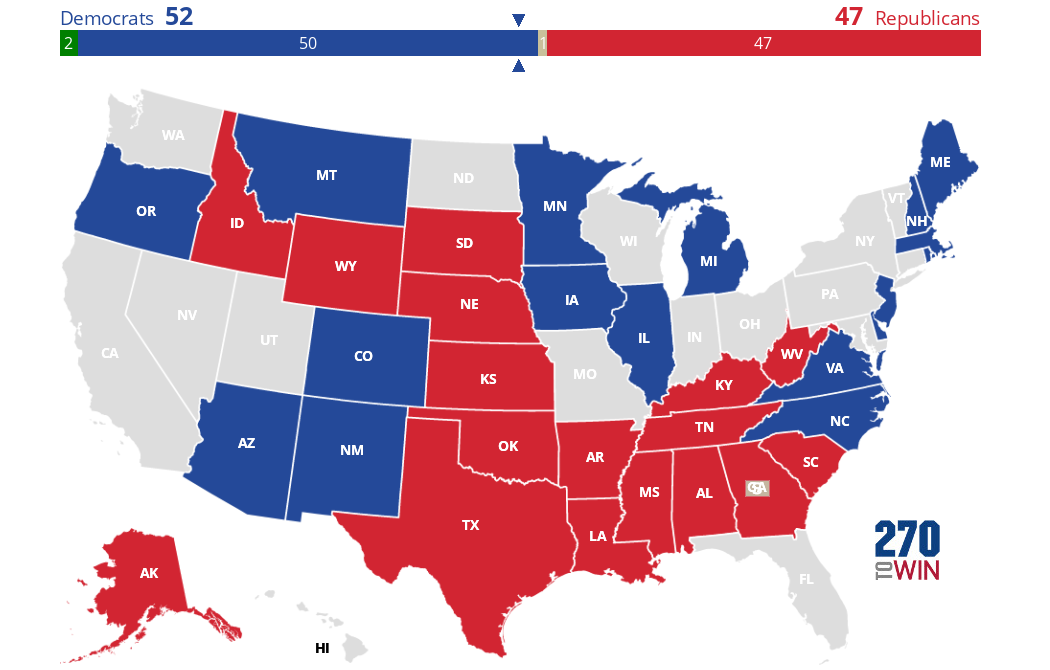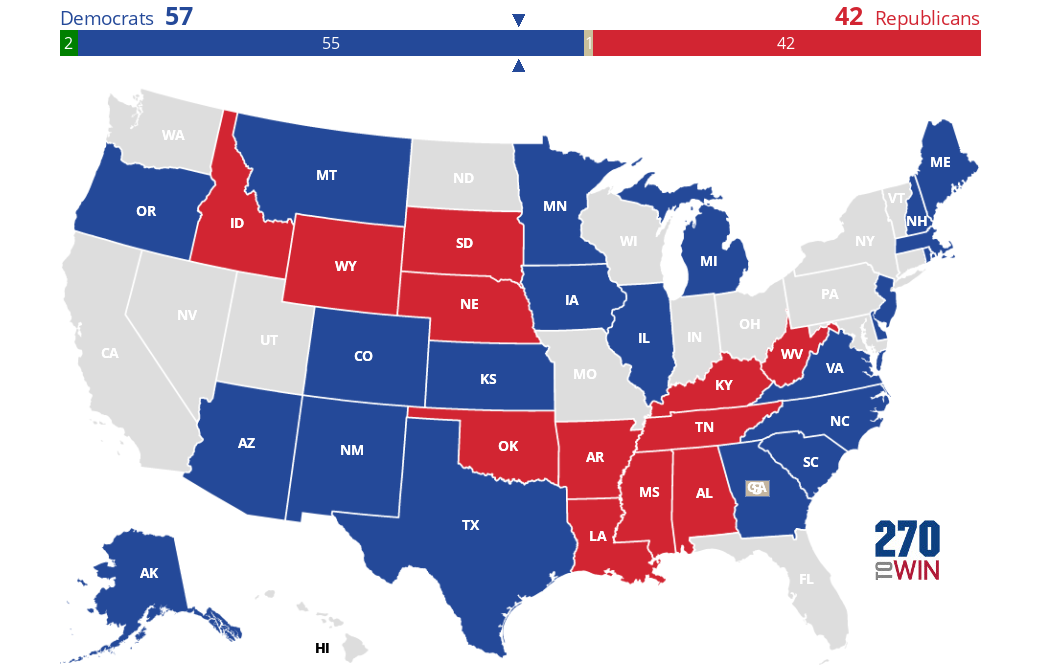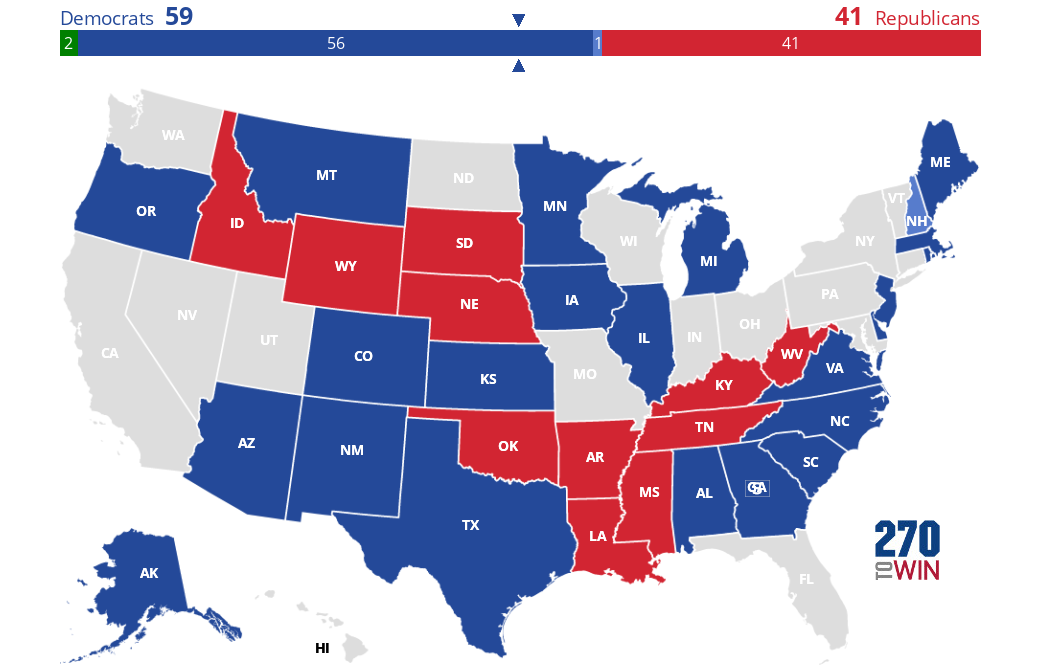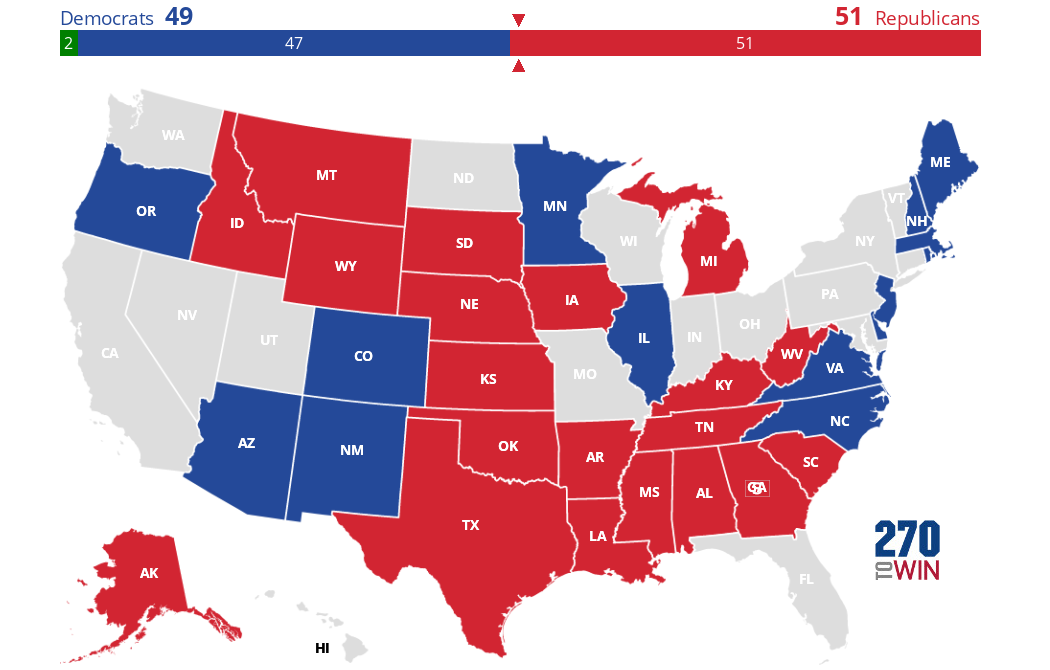Democrats could win back the Senate. A 60-vote supermajority is looking out of reach.
Even if Democrats pull off a Senate race sweep this fall, they’re almost certainly not going to get the 60-vote supermajority they need to pass bills if Republicans decide to block them.
The battle for the Senate majority is extremely close and competitive. Even though Democrats have undoubtedly expanded the battleground, there are a number of states within the polling margin of error. Basically, these races are statistically tied, and could swing to either the Republican or Democratic candidate.
Democrats need to win back at least three seats to reclaim a bare Senate majority, but they are also defending Sen. Doug Jones in deep-red Alabama, where President Donald Trump has a 28-point net approval rating. If Jones loses, as he is expected to, that means Democrats need to win four seats and the White House (where their party’s vice president could vote to break ties in the Senate), or net five seats without the White House advantage.
Overall, Senate Republicans are defending more turf: 23 seats (mostly in red states), compared to the 12 Senate Democrats who are up for reelection. Before the coronavirus hit, four states looked highly competitive for Democrats: Colorado, Arizona, Maine, and North Carolina. Now several more seats are in play for Democrats — including Montana, Iowa, and two seats in Georgia. Democratic candidates have even put other reach states like South Carolina in play. Republicans, meanwhile, are going on offense in just two states: Alabama and Michigan.
A bare majority in the Senate is 51 votes — that’s the simple majority senators can use to pass a bill. But the real magic number is 60. That’s the supermajority vote that allows the majority party to skirt the Senate filibuster and actually get to vote on a bill.
Eliminating the filibuster is a distinct possibility, for reasons my colleague Ezra Klein has reported. But to ditch the filibuster, Democrats still need 51 votes.
Let’s run through what it would take for them to get there.
The Senate battleground, briefly explained
Let’s start by outlining the map. According to Cook Political Report’s Senate race ratings, there are a couple of seats Democrats can probably count on winning, and just one Republicans can probably count in their corner.
The two Republican-held seats Cook rates Lean Democratic, or races Democrats are likely to win, are Colorado and Arizona.
The one Democratic-held seat Cook rates Lean Republican, or races where Republicans are heavily favored, is Alabama.
After that, there are seven Republican-held seats Cook rates as toss-ups, meaning these races are essentially too close to determine who is favored:
- Maine
- North Carolina
- Iowa
- Montana
- Georgia
- Georgia special election
- South Carolina
Of these, Democratic and Republican operatives alike agree the ones Democrats have the best shot at flipping are Maine and North Carolina, followed by Iowa and Montana. These four states tend to be a bit swingier; Hillary Clinton won Maine in 2016, and North Carolina is experiencing a lot of demographic change that is making it more Democratic. Iowa swings from year to year, and Montana — while reliably voting Republican during presidential elections — is more of an independent state than a conservative one, and has a history of sending Democrats to the Senate.
Political experts think the last three Southern races — two in Georgia and one in South Carolina — are probably the likeliest for Republicans to hang on to, in part because these states are traditionally more conservative. Still, there has been a lot of hand-wringing lately from GOP operatives about Georgia in particular, as that state has seen record turnout from its early voting period alone.
After the toss-ups, there are three more states Cook rates Lean Republican, and one more state it rates Lean Democratic. In other words, these are states the parties are favored to keep, but are not assured.
The three Republican-held states Cook rates Lean Republican are:
And the one Democratic-held state Cook rates Lean Democrat is Michigan.
These 14 races form the real Senate battleground. But even if Democrats pulled off the enormous feat of keeping both Alabama and Michigan and winning the other 12 seats (to be clear, this is an unlikely scenario), they would still be one vote short of a 60-vote supermajority.
Let’s go through some scenarios for what the Senate map could look like post-November 3.
The various Senate scenarios, explained with maps
The nonpartisan politics website 270 to Win has a handy interactive map that helps us visualize the different ways the Senate election could go.
Here’s what the map would look like if the Senate results follow the polls. In this scenario, Democrats lose Alabama but flip their “core four” of Arizona, Colorado, Maine, and North Carolina.
This result gets Senate Democrats the barest of bare majorities: 50 seats. Republicans would have 49 seats, assuming they keep most of their states that are rated toss-ups, and there is no immediate result in the Georgia special election (this is a likely result, as that special race is widely expected to go to a January runoff).
They would need Democratic presidential nominee Joe Biden to win the White House in order to have Biden’s Vice President Kamala Harris vote to break ties in the Senate (as vice president, Harris is also Senate president).
Things improve marginally if Democrats win about half of the seats Cook rates as toss-ups. Let’s say Democrats win Colorado, Arizona, Maine, and North Carolina, plus Montana and Iowa. In this scenario, let’s assume Democrats lose Alabama and other toss-up states South Carolina and Georgia. Again, this is assuming the Georgia special election has no winner called on November 3.
This would net Democrats 52 seats, and 47 for Republicans.
Here’s what the map looks like if Senate Democrats have a very good night and manage to flip not only all of the races Cook rates as toss-ups but also the races Cook rates as Lean Republican. This scenario assumes they lose Alabama, and that the Georgia special isn’t counted.
This gets them 57 seats, compared to 42 for Republicans. This is more than a bare majority, but it’s still three seats shy of a supermajority.
Let’s also entertain the best possible outcome Democrats could hope for: keeping Doug Jones’s seat in Alabama and flipping all of the toss-up and Lean Republican states — including eventually winning the Georgia special. This gets them all the way to 59 votes, but they would only be able to win a supermajority if they also flipped either of the two seats Cook rates Likely Republican, Kentucky and Mississippi.
Finally, let us consider the Democrats’ nightmare scenario: They lose Alabama and Michigan. Even if Democrats win their “core four” targets of Colorado, Arizona, Maine, and North Carolina but lose those two seats, it won’t be enough — they will have lost the Senate, with 49 seats to 51 for Republicans.
These scenarios underscore that even though nonpartisan election forecasters like Cook favor Democrats to take back the Senate, they are walking a very tight line to do so because they’re starting out with a deficit. It’s also worth reiterating that Democratic wins in the “core four” states aren’t assured: They’re favored in Arizona and Colorado, but the races in Maine and North Carolina are close.
In other words, there’s not much room for error from either party.
How Democrats might approach the filibuster
If they win back the Senate in 2020, Democrats recognize two things: that getting rid of the filibuster might be their only chance to truly govern in the US Senate, and that it will still be politically treacherous.
Most Democratic senators say they want to try all other options before dramatically changing Senate rules — but they also aren’t saying no outright.
“I will not turn to a reconsideration of our rules until I’ve exhausted every alternative,” said Sen. Chris Coons (D-DE), adding he’s already talking to individual Republican senators about where the two parties could find bipartisan compromise.
“I’m not telling you we’re going to eliminate the filibuster,” added Sen. Debbie Stabenow (D-MI). “Certainly there’s a real hesitancy on that because my colleagues and I want to govern.”
The thinking from many Democrats is that the first two legislative goals will be a good test of how willing the Senate GOP is to reciprocate. Covid-19 brought Democrats and Republicans together in March 2020 to pass a massive $2.3 trillion stimulus bill, and passing an infrastructure bill has been a long-held bipartisan goal that turned into somewhat of a running joke during Trump’s tenure in office.
Most moderate Democrats want to negotiate in good faith with Republicans first. And if Republicans lose badly in the election, Democrats think the GOP might have more incentive to come to the bargaining table.
“There is a breaking point when Americans look at the United States Senate and they see that the Senate under Mitch McConnell has been turned into nothing more than a vehicle for obstructing progress rather than making progress,” said Sen. Tina Smith (D-MN), who echoed she was open to all options — but likewise would not back eliminating the filibuster yet.
Biden has adopted a similar position to these Democrats. A main theme of Biden’s campaign has been returning to the days of bipartisan compromise that existed when he was in the Senate. But the former vice president has also acknowledged that the future of the filibuster depends on Republican behavior.
“It’s going to depend on how obstreperous they become,” he told Vox’s Ezra Klein.
If Republicans refuse to cooperate, moderate Democrats could be persuaded to take more dramatic action. A big stimulus and green jobs bill — and a more modest health care expansion — would be tricky but may be possible under the special legislative rules for budget reconciliation, which requires only a simple majority. But Democrats will need 60 votes in the Senate to approve most other measures with the filibuster still in place. And to eliminate it, Democrats will need 51 votes.
Whether Democrats can obtain this support is still an open question. At least five of 47 current members, including Sens. Dianne Feinstein (CA), Jon Tester (MT), and Joe Manchin (WV), have already told the Wall Street Journal they remain wary of filibuster changes. There’s also a broad range of positions on the filibuster among potential new members, with some willing to explicitly support a change in the vote threshold, while others have backed different reforms.
Filibuster reform also depends on their 2021 freshman class, and how individual candidates feel about doing away with the filibuster.
Gov. Steve Bullock in Montana and state House Speaker Sara Gideon in Maine have backed changing the 60-vote filibuster threshold in their Senate campaigns, while Jon Ossoff in Georgia has said he’s open to considering the possibility.
Veteran Cal Cunningham in North Carolina has said he’s supportive of reforms — including the possible return of the “talking filibuster.” Others, including Hickenlooper in Colorado and Theresa Greenfield in Iowa, haven’t ruled out filibuster changes, but both said they hope to advance bipartisan priorities first. Mark Kelly in Arizona, Rev. Raphael Warnock in Georgia, and state Sen. Barbara Bollier in Kansas have said they are reviewing this subject, and former South Carolina Democratic Party Chair Jaime Harrison has said he opposes eliminating the filibuster, for now.
“Basically every member of the conference is concerned about not letting McConnell paralyze the place,” Sen. Jeff Merkley (D-OR), the Democrat leading talks about filibuster reform, told Vox. “There’s a whole variety of ways we can tackle this; it will be a subject of conversation. So it isn’t one proposal.”
Author: Ella Nilsen
Read More

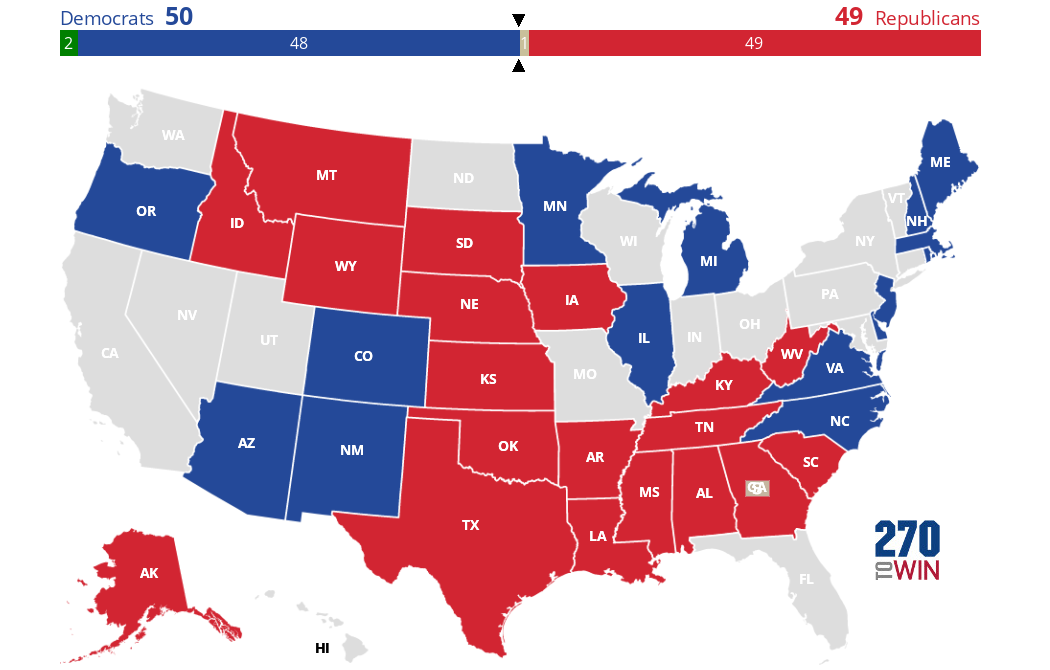
 Click the map to create your own at
Click the map to create your own at 